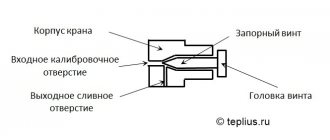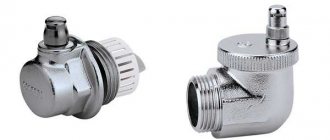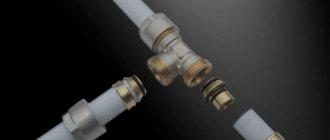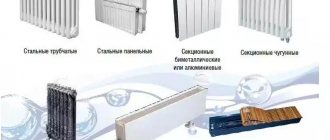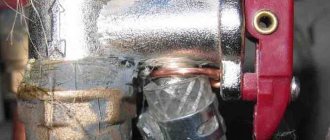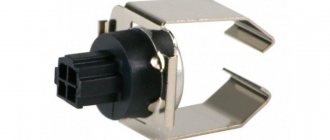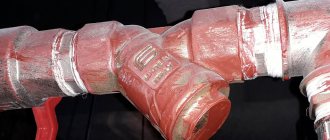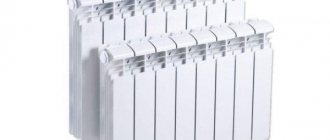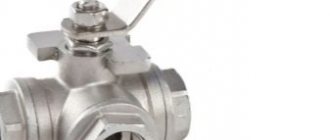Since Soviet times, the common people have used the expression “turn off the heating tap.” Then ordinary valves were cut into the cast-iron central heating radiators, through which a large amount of coolant was drained. This was done to release accumulated air in the system, which is why the radiators were downright cold. Later, a special device appeared for bleeding air from heating devices - the Mayevsky tap. In this material we will look at the design of this plumbing fixture, how it functions and is installed.
Where is the Mayevsky crane installed?
Air bubbles have much less weight than water, and therefore accumulate at the peak points of the heating circuit. In these cases, water may not fill the pipes quickly enough, there were voids in the system, and the water itself may contain large amounts of dissolved oxygen.
Possible situations for using the structure:
- The use of a Mayevsky crane should be resorted to when, at normal temperatures on the boiler, the pipes are unable to warm up the area covered.
- You should also pay attention if one section of the heating pipe remains cold, in contrast to neighboring areas.
- The consequences of improper operation of the heating system include noise during coolant circulation.
- Vibration of pipes, which, as the airlock increases, becomes more and more noticeable to home owners.
If the air lock is not eliminated in time, the inner surface of the pipes and radiators will corrode, which will require an immediate replacement of the heating system.
How to deflate
During operation, the device does not require any maintenance work.
Using the tap is very simple: before opening the valve and releasing air, you need to place a bucket under the tap and cover the tap with a rag (or polyethylene). Sprays of dirty or rusty water can fly along with the air and splash the wall, curtains or furniture. Then unscrew the screw with one hand (using a screwdriver, wrench or pen), and hold the rag with the other hand. The air will come out with a hiss when water starts to drip - tighten the screw tightly.
You can clearly see the progress of work on using the air valve in our video:
Design of the Mayevsky crane
The familiar Mayevsky crane has been known for a long time, and has not changed its shape and design since its creation. This device has the following components:
- Frame.
- Cone-shaped screw with a head. The head shape is designed specifically for the turnkey.
- Another mandatory element is the rotating part.
The device of a classic hand-held product also includes two channels for moving air from the system. How the Mayevsky crane works:
- The start of the crane operation is initiated by the launch of the rotating part. Previously, turning was done manually with a screwdriver.
- Today, the design of the crane provides for the presence of an external key, which operates this device.
The price for a Mayevsky crane (for a manual model) ranges from 40 to 150 rubles.
Installation of "Mayevsky" on a cast iron battery
Installation of drain valves on the liners of aluminum and steel radiators is quite simple and does not require a detailed description. The valve with the rubber ring is carefully tightened with a small force of the key, then the nylon cap is turned in the desired direction. A valve with a wide plastic ring and a hole in a metal body is immediately fixed in the required position - with the outlet fitting downwards.
Another thing is installing a valve in a cast iron radiator plug of type MS-140. Some craftsmen make a homemade faucet - drill the fitting, cut a thread and screw in a simple bolt. The option is extremely primitive and inconvenient - when the bolt is loosened and the air is released, an uncontrolled leak will form.
How to install Mayevsky correctly without unscrewing the stuck fitting:
- Buy an old-style faucet with an M10 x 1 landing thread and be sure to prepare the appropriate taps - numbers one and two. The so-called machine tap will not work - cast iron is too hard, the tool will simply break.
- Empty the heater and drill out the top plug first with a thin drill bit, e.g. Ø5 mm.
- Carefully break the hole with a Ø9 mm drill, then chamfer it to ensure the tool fits in securely.
- Cut the thread by alternately passing the hole with taps No. 1 and 2. Check how well the valve is screwed in.
- Having sealed the threads with flax, tighten and tighten the tap with medium force.
Advice. Drilling cast iron and cutting threads should not be done “dry”. Be sure to lubricate the tool with machine oil, otherwise the working edge will quickly become dull.
An easier way is to replace the standard liner with a new one, with a ready-made hole for the “air vent”. In this case, a modern valve with an external thread G½” (15 mm) is used. The main thing is to successfully unscrew the old battery plug. How to install “Mayevsky” on the MS-140 radiator, watch the video:
Types of cranes based on operating principle
The production of sanitary products does not stand still, and therefore the Mayevsky faucet now has an automatic analogue. The development of automatic taps is associated with a shortage of free space in residential premises.
In this case, pipes and radiators are placed in the most inaccessible places. For such situations, an automatic tap is used, which independently opens the valve under the influence of excess pressure.
What is it and what is it for?
This is a shut-off valve of a very simple and reliable design for releasing air from a closed system, manually controlled. It has existed for almost ninety years and is used almost in its original form to this day.
Its other names are: radiator needle air valve, air bleed valve, the most common is the Mayevsky valve. In textbooks, the name radiator needle air valve is usually used.
Types of taps by material of manufacture
In addition to the principle of operation, all Mayevsky cranes differ depending on the material used. Both metal and plastic models are extremely popular in practice.
The most famous cranes include:
- Steel products. This alloy is made by combining iron and carbon, and sometimes several other impurities. Such cranes are characterized by increased strength, low weight, and easy maintenance requirements.
- Brass, from which mechanical Mayevsky taps are most often made. This material has a high degree of resistance to corrosion and can serve for a long time without deterioration. In addition, this alloy is absolutely safe for others, for residents of a house or apartment.
- Taps made of cast iron. Cast iron has sufficient strength that allows you to use the product for a long time in everyday life. The main disadvantage is the very significant weight of the product, which creates additional load on the fastenings of the heating pipes.
Sometimes in apartments you can find a plastic tap installed on heating radiators. This model has low cost, but low strength.
Accidental damage to the structure is possible when the valves are opened excessively or when cleaning the outlet from dirt. Therefore, plastic products will have to be changed quite often.
Types and designs
There are practically only two types of Mayevsky crane: manual and automatic.
The automatic valve is not very suitable for central heating systems - it gets clogged easily. This device operates without human intervention - it contains a float that opens the valve when air appears.
The manual model has a very simple and functional design, it performs one single function, so all products have the same design.
1 – brass body; 2 – working screw with ducts; 3 – nylon cap; 4 – sealing ring.
The types of valves are shown in the photo:
1. Mayevsky crane for tools (imported type); 2. Mayevsky tap at hand (imported type); 3. Domestic type of Mayevsky crane
Differences
There are fundamental differences only in the diameter of the external thread on the body: there are products with diameters of ½'' and ¾' (15 and 20 mm)'. There are products with a diameter of 1 inch.
The screw can be unscrewed using a screwdriver or a special wrench. The screw head has a square shape (occasionally a hexagonal or octagonal head) and a slot for a flat-head screwdriver. The key is supplied with the valve. There are models with a handle for unscrewing the screw.
The marking indicates the connecting diameter in millimeters; thread parameters are designated M10×1 - length 10 mm, metric thread pitch 1 mm.
Features of operation of a mechanical crane
The Mayevsky tap is usually located at the end of the battery or radiator. To normalize the operation of the heating system, you should use the instructions on how to bleed air using a Mayevsky tap:
- The tap is opened using a key or screwdriver.
- Air valves start in a clockwise direction and close in the opposite direction.
- As soon as the characteristic hissing (sometimes whistling) stops, the tap can be closed.
- A separate situation is when a forced coolant circulation pump is installed in the heating system. Before bleeding the air, turn off the pump and wait up to 5 minutes. In this case, the movement of the coolant will completely stop, and the air plug will rise to the upper tier of the radiator.
- The hole intended for bleeding air may become clogged with dirt. Don't worry, dirt can be quickly removed with a needle or pin.
The operation of the Mayevsky crane for cast iron pipes deserves special attention. Such heating systems are very dirty, so the owner will have to frequently clean the tap outlet. It is also worth abandoning the automatic crane model in such a situation.
Conclusion
Today you learned about such a wonderful device as an air vent. Examples were given of what the device is needed for and where it is used. Since its sizes are different, you just have to choose the appropriate one, for example, a Mayevsky 3-8-inch, half-inch or other option. Installation of the device does not cause problems, large financial expenses, effort and time.
With the help of such a device it is possible to significantly increase heating efficiency. The video in this article will give you the opportunity to find additional information on the above topic.
Did you like the article? Subscribe to our Yandex.Zen channel
Features of operation of an automatic crane
Automatic models are very convenient in private homes, where cast iron pipes have been replaced with more modern plastic products. Such structures do not have serious contamination, and therefore are not capable of disrupting the operation of the crane.
- Inside the automatic device there is a chamber equipped with a float. The float is connected to a needle valve located at the top of the housing.
- As soon as the air lock creates pressure above the specified limit, the valve is activated and opens, freeing the air channel.
- As soon as the pressure in the heating system decreases, the valve closes due to the float.
This feature prevents water or coolant from leaking from the system.
Automatic Mayevsky cranes are very convenient for practical use, but they are more expensive than mechanical models.
Selection tips and prices
Buy valves at the store, not at the market. Preferably with a receipt. Although their design is simple and reliable, defective products still happen - they can be replaced. Do not buy steel products (if you happen to come across them); the ideal material is brass.
If there is a handle on the screw, bleeding the air will be much easier. And children at an interesting age too. Therefore, when choosing such a model, soberly assess the age and degree of playfulness of children's hands.
Don't go wrong with the case diameter.
Photo of Mayevsky crane
Expert advice
Water appears in the network quite often. Therefore, it is recommended to install air vents in each heating battery, register, U-shaped compensators with a loop turned upward, and at the highest point of the system.
It is necessary to unscrew the screw one to one and a half turns. This is quite enough. If you unscrew the screw too much, it will be difficult to screw it back in under pressure, and quite a bit of water will spill out.
If you want to install a valve in the cast iron plug of an old cast iron battery, it is better to replace the plug.
Drilling a hole and cutting threads in cast iron is extremely problematic due to its particularity - great fragility.
Rules of service
Uninterrupted operation of the drain valve is possible only if the rules for its operation are observed:
- To bleed air, open the tap. If the air flow does not stop after a few minutes, it means that there is an additional suction in the system. To check the tightness, take a thin sheet of paper and pass it around all the joints. In places where there is suction, the sheet will be drawn to the joint.
- If the exhaust channel is dirty, clean it with a thin needle or wire.
- With infrequent use, the faucet becomes corroded and stops working. To correct the situation, treat the faucet with WD-40. For preventive purposes, after the end of the season, the threads should be treated with silicone grease.
- The faucet cannot be repaired and must be replaced if broken. Dismantling must be done using an auxiliary adjustable wrench to fix the radiator cap. Otherwise, the radiator itself may be damaged.
When using an ion boiler with a closed coolant circulation system, the faucet will not last long. A brine solution is added to the coolant for such a system to ensure the acceleration of ions in the boiler. When bleeding air, salts will be deposited inside the valve, which will lead to failure. For ion boilers, devices are provided that are resistant to salt.
Reviews
- Many, having tried to bleed air using the Mayevsky tap, discovered that this was a rather lengthy process. However, this is to be expected.
- A number of buyers set out to find branded faucets from foreign manufacturers. As a result, they were disappointed that they could not be distinguished externally, nothing confirmed their “noble” origin, and it was impossible to check whether you were really overpaying for nothing.
- Those who installed automatic taps were faced with another feature - the inability to drain water when the need arose. Installed together, the air vent and drain valve looked cumbersome.
- Another unpleasant moment from user experience is that the faucet jammed so much that both it and the radiator plug had to be replaced. The reason is the long inactivity of the mechanism.
Where can I buy?
Some domestic manufacturers and suppliers:
- OJSC Bologovsky Valve Plant offers inexpensive taps (about 35 rubles) Telephone 223-08-98, 660-27-53, Moscow.
- LLC Penzapromarmatura Tel., Penza.
- On the website of the Santekh-Detal company you can purchase taps from such foreign manufacturers as General Fittings, Itap (Italy), Microtecnica Trevisana at affordable prices. Tel.
- You can also purchase expensive Itap air vents from the Abion plumbing company (address in Moscow, Nagatinskaya St., 29, building 4).
Beware of low-quality fakes of dubious production. They may crack during installation.
Specifications
Mayevsky’s external thread is standard:
- 1 (marking DN 25);
- ½ (DN15);
- ¾ (DN 20).
Where the marking in brackets is the diameter of the tap.
Other characteristics:
- Pressure – 10 Bar;
- Temperature –120-150 °C;
- Weight – 25-80 g.
If the operating pressure of the system exceeds 10 Bar (which does not happen often), you need to use a standard tap, which is designed for 16 units.
To install Mayevsky in a plastic pipe system, you will need a fitting. Installation into a metal pipeline is more complex - it will require welding and worker skill. In radiators, the fitting is simply screwed into the side opposite to the heating connection.
Manufacturers do not recommend using a Mayevsky faucet with cast iron radiators - large amounts of scale and rust, which are always present in old radiators, can clog the passages and damage the device. In a hopeless situation, we can recommend brass taps.
Nuances during operation
In order for the process of bleeding accumulated air in the system to occur without undesirable consequences, detailed instructions for all manipulations are given below.
- If the movement of the heat exchanger occurs due to the circulation pump, then it needs to be turned off. This is done 15 minutes before the start of work. This is necessary so that the air stops mixing with water and accumulates at the top point of the battery.
Disabled pump
- Stock up on a dry rag and an empty bucket, because when you open the valve, you need to wait until the air stops hissing, followed by water. You can close the valve only when the water begins to flow in an even, uninterrupted stream.
- What to do if the air does not stop bleeding? Look for a breakdown or loose twist in the area of the battery being serviced. This can be done using a piece of paper. Leave the valve open and move the paper from a distance of 1 cm over all possible places on the radiator and pipes suitable for it. Having found a place where air is leaking, replace the damaged element.
- When the air vent system has not been used for several years, the valve threads may become sour. You will have to use a lubricant like WD-40, and then lightly tap the tap and try to unscrew it.
Solvent Grease WD-40
